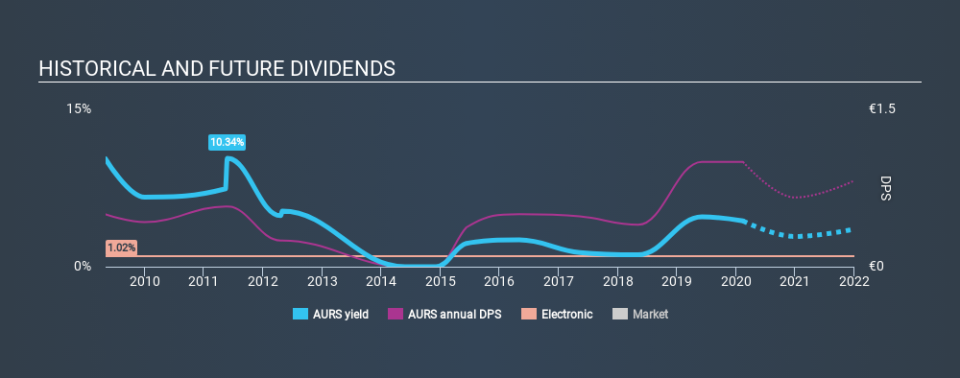Should You Or Shouldn't You: A Dividend Analysis on AURES Technologies S.A. (EPA:AURS)

Dividend paying stocks like AURES Technologies S.A. (EPA:AURS) tend to be popular with investors, and for good reason - some research suggests a significant amount of all stock market returns come from reinvested dividends. If you are hoping to live on the income from dividends, it's important to be a lot more stringent with your investments than the average punter.
With AURES Technologies yielding 4.4% and having paid a dividend for over 10 years, many investors likely find the company quite interesting. We'd guess that plenty of investors have purchased it for the income. The company also bought back stock during the year, equivalent to approximately 1.6% of the company's market capitalisation at the time. There are a few simple ways to reduce the risks of buying AURES Technologies for its dividend, and we'll go through these below.
Click the interactive chart for our full dividend analysis
Payout ratios
Dividends are typically paid from company earnings. If a company pays more in dividends than it earned, then the dividend might become unsustainable - hardly an ideal situation. As a result, we should always investigate whether a company can afford its dividend, measured as a percentage of a company's net income after tax. AURES Technologies paid out 87% of its profit as dividends, over the trailing twelve month period. Paying out a majority of its earnings limits the amount that can be reinvested in the business. This may indicate a commitment to paying a dividend, or a dearth of investment opportunities.
We also measure dividends paid against a company's levered free cash flow, to see if enough cash was generated to cover the dividend. Last year, AURES Technologies paid a dividend while reporting negative free cash flow. While there may be an explanation, we think this behaviour is generally not sustainable.
Consider getting our latest analysis on AURES Technologies's financial position here.
Dividend Volatility
From the perspective of an income investor who wants to earn dividends for many years, there is not much point buying a stock if its dividend is regularly cut or is not reliable. For the purpose of this article, we only scrutinise the last decade of AURES Technologies's dividend payments. The dividend has been cut on at least one occasion historically. During the past ten-year period, the first annual payment was €0.50 in 2010, compared to €1.00 last year. Dividends per share have grown at approximately 7.2% per year over this time. AURES Technologies's dividend payments have fluctuated, so it hasn't grown 7.2% every year, but the CAGR is a useful rule of thumb for approximating the historical growth.
It's good to see the dividend growing at a decent rate, but the dividend has been cut at least once in the past. AURES Technologies might have put its house in order since then, but we remain cautious.
Dividend Growth Potential
With a relatively unstable dividend, it's even more important to evaluate if earnings per share (EPS) are growing - it's not worth taking the risk on a dividend getting cut, unless you might be rewarded with larger dividends in future. It's good to see AURES Technologies has been growing its earnings per share at 23% a year over the past five years. A majority of profits are being paid out as dividends, which raises the question of what happens to the current dividend if earnings decline. However, the rapid growth in earnings may indicate that is less of a risk.
Conclusion
When we look at a dividend stock, we need to form a judgement on whether the dividend will grow, if the company is able to maintain it in a wide range of economic circumstances, and if the dividend payout is sustainable. AURES Technologies gets a pass on its dividend payout ratio, but it paid out virtually all of its cash flow as dividends. This may just be a one-off, but we'd keep an eye on this. We were also glad to see it growing earnings, but it was concerning to see the dividend has been cut at least once in the past. Ultimately, AURES Technologies comes up short on our dividend analysis. It's not that we think it is a bad company - just that there are likely more appealing dividend prospects out there on this analysis.
Earnings growth generally bodes well for the future value of company dividend payments. See if the 3 AURES Technologies analysts we track are forecasting continued growth with our free report on analyst estimates for the company.
Looking for more high-yielding dividend ideas? Try our curated list of dividend stocks with a yield above 3%.
If you spot an error that warrants correction, please contact the editor at editorial-team@simplywallst.com. This article by Simply Wall St is general in nature. It does not constitute a recommendation to buy or sell any stock, and does not take account of your objectives, or your financial situation. Simply Wall St has no position in the stocks mentioned.
We aim to bring you long-term focused research analysis driven by fundamental data. Note that our analysis may not factor in the latest price-sensitive company announcements or qualitative material. Thank you for reading.

 Yahoo Finance
Yahoo Finance 
